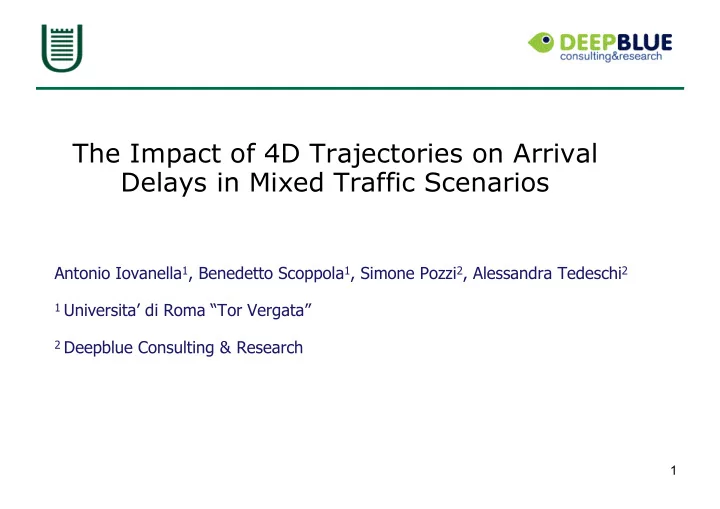

The Impact of 4D Trajectories on Arrival Delays in Mixed Traffic Scenarios Antonio Iovanella 1 , Benedetto Scoppola 1 , Simone Pozzi 2 , Alessandra Tedeschi 2 1 Universita’ di Roma “Tor Vergata” 2 Deepblue Consulting & Research 1
Problem statement Impact of arrival variability of overall delay: - To what extent is the reduced variability of arrival times going to benefit the ATM performance in terms of delays? - Can we increase capacity in large airports by increasing predictability? SESAR Scenario to be considered: - mixed traffic with 4D aircraft and non-4D aircraft - different percentages of 4D aircraft and non-4D aircraft 2
State of the art Existing queue models for air traffic congestion assume the Poisson distribution to calculate delays. Very reasonable fit between: - observed inter-arrival times - exponential distribution (typical of Poissonian arrivals) Much worse fit between: - the observed distribution of the delays - delays with Poissonian arrivals
Observed vs Poisson
How to measure delays t app defined as “the time from the beginning of the STAR to the touchdown” Delay = actual t app - estimated t app estimate t app = many option, e.g. the calculated time. Open issues: - Negative queueing times for some flights - The tail of the distribution is clearly too fat
Construction of PSRA 1 Pre-scheduled random arrivals (PSRA) An alternative arrival process: 1. Start from an homogeneous pre-schedule t 6
Construction of PSRA 2 2. Delete from the pre-schedule some arrivals, in order to have a working load of the runway smaller than the capacity t 7
Construction of PSRA 3 3. Then add a random delay to each aircraft: some of them will arrive later… t 8
Construction of PSRA 4 …some of them will arrive in advance… t 9
Construction of PSRA 5 4. End result: - the memory of the initial pre-scheduling is lost - the distribution of the interarrival times is very close to an exponential one t 10
A better fit
SESAR scenarios Use of PSRA to simulate SESAR scenarios Two dimensions: - percentage of 4D aircraft and non-4D aircraft - ATM disciplines applied: • first-come, first-served (FIFO) • best-equipped, best-served (BEBS) [early adopters of SESAR avionics receive a ”preferential service” over non-equipped (debated)]
SESAR scenarios Use of PSRA to simulate SESAR scenarios Assumptions: - 4D aircraft timely declare any delay, no impact on slot allocation - they reach the beginning of the STAR respecting their Controlled Time of Arrival.
Our simulations SESAR scenarios to be compared: - baseline scenario: first-come, first-served, no 4D a/c - initial 4D scenario : first-come, first-served, 33% 4D a/c - advanced 4D scenario : first-come, first-served, 66% 4D a/c - target 4D scenario : first-come, first-served, 100% 4D a/c - initial best equipped 4D scenario : best-equipped, best-served, 33% 4D a/c - advanced best equipped 4D scenario: best-equipped, best-served, 66% of 4D a/c
Results: FIFO 33%
Results: FIFO 66%
Results: BEBS 33%
Results: BEBS 66%
Time spent in queue The time in queue is expressed in a unit equal to the landing time (not minutes!)
Conclusions 1) 4D trajectory management enhances the ATM system overall predictability, only if the adoption of 4D technologies is widespread 2) ‘Mixed traffic’ situation are difficult to manage: it affects both the efficiency and the ‘fairness’ of the overall system
Future works - Simulation of other prioritisation policies, including the refinement of the existing ones. -The introduction of time critical activities in the slot allocation: - e.g. short term change of the slot allocation due to the late downlink of an “unable to comply” message by one (or more) aircraft -Drastic restructuring of the whole slot allocation: - e.g. sudden (with immediate effect) notification of a new ATM constraint, triggering the recalculation of the Target Arrival Time by a large percentage of all the aircraft involved
Thanks for your attention! Questions? scoppola@mat.uniroma2.it 22
Recommend
More recommend